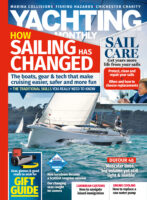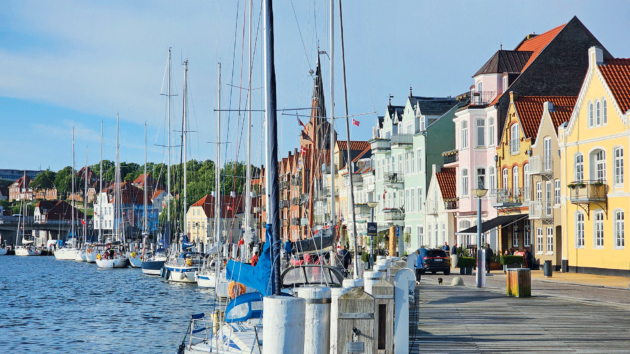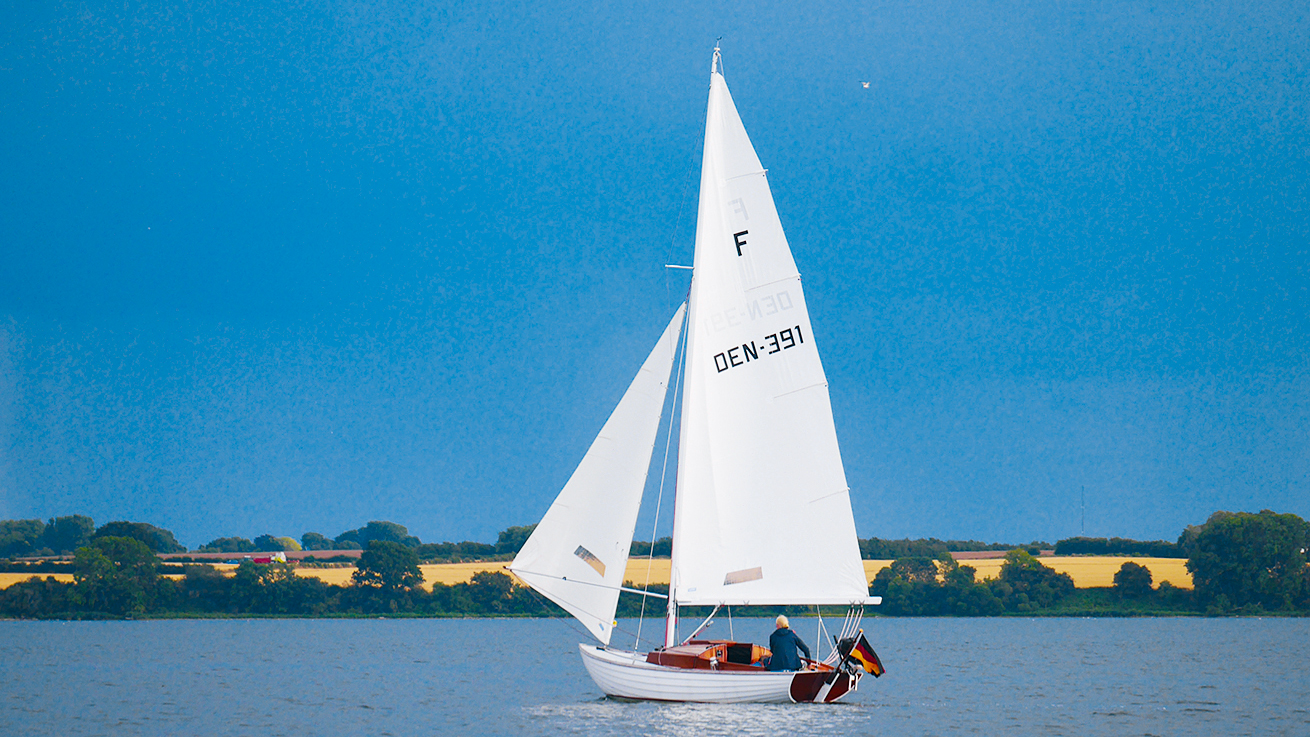Chris Carr ventures out to visit just a few of the hundreds of Danish islands in the South Funen Archipelago
The Danish islands between Jutland, the continental part of Denmark, and Sweden had long been on my wish-list as a charter destination, but with 1,400 islands in total, just 409 of which are named and only 70 populated, my question had always been where to start. Two of the largest islands (Funen and Zealand) look like giant stepping stones between the Danish mainland and Sweden, connected by ‘belts’ (shipping channels) so one of these seemed the obvious starting point.
I found a German company online which had a large selection of around 20 charter bases from Juelsminde in Denmark down to Kroslin near the German border with Poland. It also had a useful cruise planner on its website. We opted for the base of Flensburg because it seemed to have the biggest selection of yachts.
Uninhabited Danish islands
Created by a dramatic rise in sea level after the last Ice Age, the South Funen Archipelago is characterised by shallow coastal waters, uninhabited islands, saltmarshes and reedbeds and is an internationally important area for many waterbirds. These waters are some of the most attractive and well sheltered in Denmark with short distances and only a very small tidal range but still some current to look out for in narrow channels.
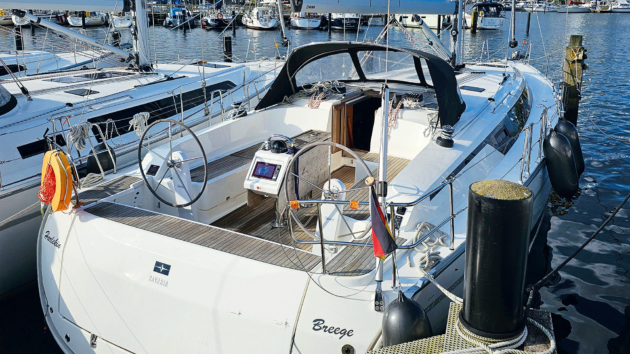
The Bavaria C46 was roomy with four separate cabins yet only had a draught of 1.75m. Photo: Chris Carr
We arrived at the Mola Yachting base at Marina Niro Petersen, a short walk from the centre of Flensburg, at 1400, the start of the handover window. Base manager Henrik led us onto the pontoon to the 2022 Bavaria C46 – our home for the week.
The end section of Flensburg fjord lies in a north-south direction. Walking into town for lunch along the western side, the road cuts inland behind some factory or wharf buildings but soon returns to the waterfront where traditional boats line the Flensburg harbour museum. With more time, the nearby museum for shipping and shipbuilding also looked well worth a visit.
Fuelled by breakfast at a local café, we motored out of Marina Petersen at 1000, passing the imposing red-brick Mürwick Naval Academy on the southern shore. With a 14-knot wind blowing behind us from WNW we flew down the inner section of the fjord on a broad reach towards the Holnis narrows, a U-bend in the fjord created by the Holnis peninsula on the south side and the Broager on the north.
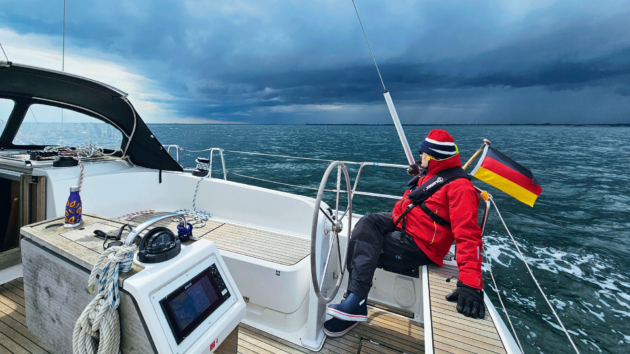
Leaving Faaborg. This squall on the horizon helped us decide on S0nderborg to the south as our next destination, leaving Dyvig for next time. Photo: Chris Carr
It was a busy Sunday, with many classic boats out on the water, which made for exciting sailing especially around the northern tip of the Holnis peninsula.
At the outer section of the fjord, we noted the masts at Langballe on the southern shore which, only 10 miles from Flensburg, we’d considered for the previous night. With the wind blowing from the west, we sailed the angles downwind until at 1430, we reached the impressive red and white striped Kalkgrund lighthouse at the entrance to the Flensburg fjord which marks the end of 1.7 miles of sand spit and reefs between it and the southern shore.
We then turned southeast towards the mouth of the Schlei inlet giving the coast plenty of clearance until we picked up the safe water marker at the entrance.
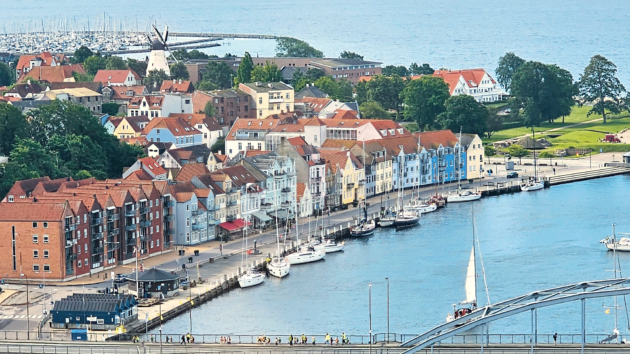
Sonderborg bridge, waterfront, castle windmill and yacht harbour in the distance taken from the lookout platform on the 16th floor of the Alsik Hotel. Photo: Chris Carr
The Schlei’s narrow entrance is marked by a green and white lighthouse at the northern end of a breakwater. To the south is the Baltic Sea resort of Olpenitz built on a former naval base. From the entrance, the inlet stretches 20 miles ending at the city of Schleswig.
At first, the inlet is wide and open, but the navigable part is narrow and marked by buoys, with a large marina at Maasholm on the north side. Past Rabelsund, the inlet bent round to the south and narrowed as we headed towards Kappeln.
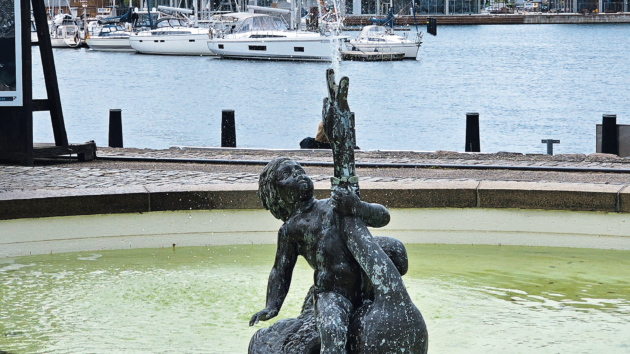
A long jetty in Svendborg’s North harbour has plenty of alongside berths. Photo: Chris Carr
With a bascule bridge (a moveable bridge with a counterweight) to negotiate at Kappeln which opened at 40 minutes past every hour, we joined several other yachts pottering along as we all counted down the clock. At the bridge on the east side is the 15th-century W-shaped herring fence made of ash on the waterline which relies on the strong current to draw the silverlings down to the narrow end of the fence.
Article continues below…
‘Every time you turn on your engine, the exhaust water makes the sea more acidic’
The sun shines bright in the sky and the gentle wind moves a lock of hair on my cheek. I…
Sailing to ‘a picture-book village, with ancient houses and shaded alleyways’
Ghosting up the narrow Als Sound, with only the faintest breeze over glassy water, through a beautiful, picture-book scenery that…
Empty box mooring
Once through the bridge, the first mooring option is the Arnisser Sailing club which has two enclosed mooring bays with an entrance at both ends. We motored on in search of a larger space, passing the classic boats in the Museumshafen. At the next pontoon, we found an empty box mooring which was very easy to enter bow-first against the tidal flow with a pontoon that was level with the deck. Hurrah!

It’s a 20-minute walk from S0nderborg marina into town along the seafront, or you can hire bikes
from the marina office. Photo: Chris Carr
This turned out to be Fin marine services which had three pontoons arranged around a new bistro called the Seagull and top-notch shower facilities. We had a short walk back into Kappeln for dinner along a very picturesque tree-lined path with classic boats to ogle at along the way.
We slipped our mooring at 0920 ready for the 0940 bridge opening and made it back to the Schleimunde at 1030. With 16 knots from the west and a single reef we sailed north on a beam reach crossing from German into Danish waters towards Skoldnaes lighthouse at the northern tip of the Danish island of Aero.
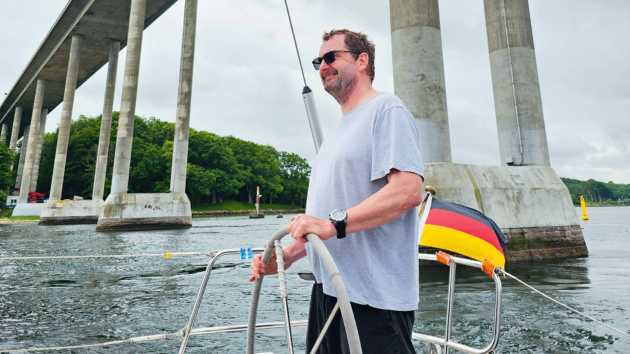
The Svendborgsund Bridge is an impressive 33m bridge that connects the island of Funen with the island of Tåsinge. Photo: Chris Carr
The wind was now up to 20 knots so we put in a second reef to sail back down the east side of the island past the commercial harbour of Soby and on towards Aeroskobing.
The first sign of the harbour is the northern tip of a long narrow peninsula called Urehoved which juts out above Aeroskobing and then curves north parallel with the shore forming a natural bay. Sailing down the outside of the peninsula we reached the safe water mark and motored up the Mollegabet (narrow channel) between the small island of Dejro and Urehoved into the harbour for 1600.
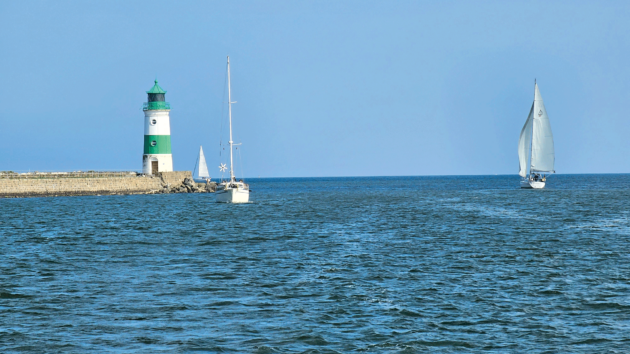
The entrance to the narrow inlet Schlei is marked by a lighthouse at the end of a causeway. Photo: Chris Carr
We chose the yacht harbour over the commercial harbour but with 25 knots of wind blowing by this stage we had to do a few circuits of the harbour surveying the seemingly tiny mooring spaces. Fortunately, the harbourmaster came to our rescue by pointing out a row of larger spaces that we’d completely missed at the northern end. The marina has shower facilities set in a sandy playground area with barbecue huts.
With a shorter day’s sail ahead, we explored the old town, finding a bakery, Bageri Aps, on west street and a smokery down by the harbour to stock up on supplies. At 1100, with light winds from the SE, we slipped our mooring and headed north under full sail towards Svendborg on Funen.
An hour later, with the islands of Drejo and Hjorto abeam, we dropped our sails and entered the narrow, buoyed channel which runs as far as the western edge of Tasinge island.
Ahead of us, the water narrowed into a pretty tree-lined Svendborg sound between Funen and Tasinge and took us under the 33m Svendborg road bridge. Our destination, the sheltered north harbour in Svendborg, is situated behind an old shipyard called Frederikso built on a man-made island.
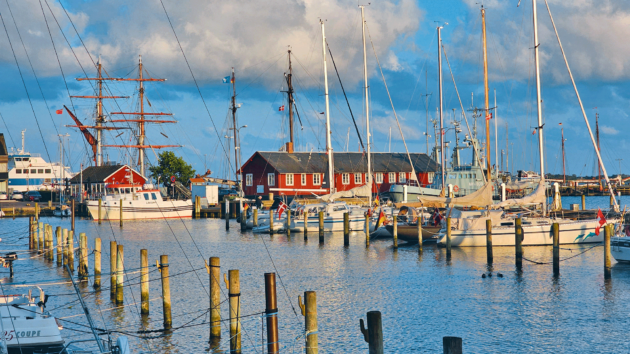
The picturesque old harbour in Faaborg is still very active and in constant use by commercial vessels and fishermen. Photo: Chris Carr
The seaward side of the island is still an active working harbour with dry docks, but the land side has been reinvented for tourism with a museum of sailing and a couple of bar restaurants. At 1415 there were plenty of places to tie up. We walked into town through a maze of shopping streets which lead us to an attractive cobbled main square with a large red brick Lutheran church at the top and tree-lined avenues.
We got away at 0930, motoring west back the way we came, into the wind. When we got to the edge of Tasinge, instead of turning south to Aeroskobing, we continued straight on towards Faaborg. Once we had passed the northern tip of the tiny island of Skaro, we tacked up towards Avernako island then had a glorious five-mile sail on one tack in full sunshine straight into Faaborg.
There, we motored past the commercial harbour and round the back of the northern yacht harbour just outside town to an alongside mooring on an outside pontoon, arriving at 1300. The marina building had shower facilities and a restaurant and bar upstairs. The town, with its very attractive old buildings, clocktower and cobbled streets, is less than a 10-min walk. We took a small detour to visit the Bad Og Motor chandlery for a bottle of gas.
Changeable forecast
The wind was blowing southwest at 11 knots but the forecast looked changeable. We left Faaborg at 1000 and followed the narrow-buoyed channel between the poppy-covered fields on Bjorno and the town of Dyreborg on Funen and then between the islands of Avernako and Lyo where we hoisted our sails.
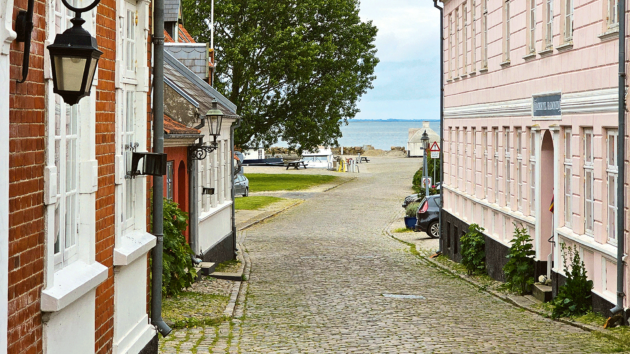
Ǣer0sk0bing’s cobbled streets and colourful houses preserved in the style of the 18th century. Photo: Chris Carr
Our plan had been to sail WNW and then around the northern tip of Als to the popular natural harbour of Dyvig. However, at 1230, as we nosed out into the Little Belt, a 25-knot squall caught us off-guard as we were tacking, tangling our genoa sheets which took some time to undo.
We carried on sailing our original course for a while but with the sky turning increasingly dark, we revised our route and headed south on a beam reach towards Gammel Pol lighthouse at the southern tip of Als and with a new destination of Sonderborg. We motored the last leg into the wind and arrived into Sonderborg at 1730.
About turn
Sonderborg sits at the mouth of the Alssund which separates the island of Als from the mainland, spanned by the Christian X Bridge. We had nosed into the harbour near the bridge but the posts along the waterfront did not look too boat-friendly, so we did an about turn and headed for the marina just outside the entrance to the sound.
There’s a lovely, paved walkway along the shore here with bronze sculptures along the way. When you reach a small sandy beach, the path cuts inland around the back of Sonderborg Castle and brings you to the harbour.
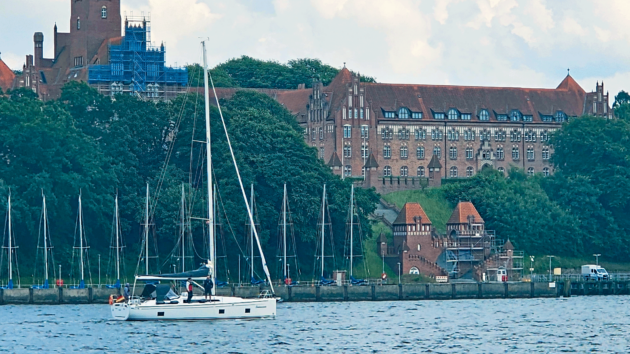
The pretty roof line of Faaborg from the sea makes for an enticing haven against the brooding sky. Photo: Chris Carr
With only a short sail ahead of us back to Flensburg, we rented bikes from the harbour office and headed for the Alsik Hotel and Spa which has a great view from the 16th floor. The bikes were great for exploring the back streets with a good range of shops and coloured umbrellas glowing in the sunshine as they hung from wires across the street.
We cycled back to the marina and by 1115, we were under way. With a SW wind at 12 knots to begin, we had a short tack out to the middle of the fjord then an exhilarating broad reach towards the Holnis narrows. We realised that the final turn towards Flensburg at the narrowest point would mean going head to wind without much room to tack so we started the engine just in case.
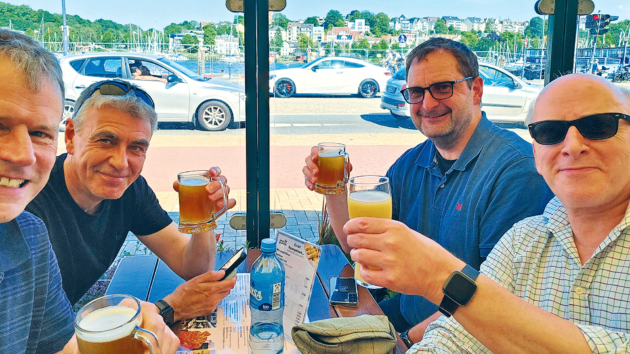
The holiday begins with lunch at Hansens brewery on Flensburg waterfront. Photo: Chris Carr
As we rounded the final marker, the wind notched up again to over 20 knots possibly due to some funnelling effect on the wind in the inner part of the fjord.
But an earlier sail change had done the job and we had a brilliant final couple of hours tacking up the fjord trying to get ahead of the other boats that were also heading for port. Back in Flensburg, we spent our final night at The Harbour Kitchen and started planning our return to the Baltic.
Enjoyed reading this?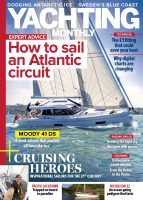
A subscription to Yachting Monthly magazine costs around 40% less than the cover price, so you can save money compared to buying single issues.
Print and digital editions are available through Magazines Direct – where you can also find the latest deals.
YM is packed with information to help you get the most from your time on the water.
-
-
- Take your seamanship to the next level with tips, advice and skills from our experts
- Impartial in-depth reviews of the latest yachts and equipment
- Cruising guides to help you reach those dream destinations
-
Follow us on Facebook, Twitter and Instagram.
Note: We may earn a commission when you buy through links on our site, at no extra cost to you. This doesn’t affect our editorial independence.

